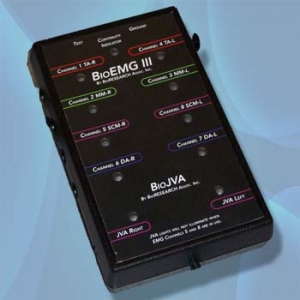
BioEMG III™
Surface EMG is the worldwide standard method for recording muscle-specific activity in skeletal muscles. It has been proven reliable in numerous studies over many years and is a clinical procedure that can easily be performed in any dental office.
This information is invaluable to the clinician that hopes to create beautiful dentistry that works with the patients physiology for optimum results.
Gain Confidence, Stop Guessing!
SEMG is the only way to objectively measure the actions and reactions of the muscles of the head and neck. This provides each clinician the ability to test his treatments and bite positions before finalizing the treatment position. With BioEMG III you can give up “HOPE” dentistry.
Stop hoping your bite is right for your patients muscles, stop hoping your restorations will not lock in muscle spasm, start feeling the freedom and confidence that comes with objectively testing your patients muscles with BioEMG III.
Highest Noise Rejection
Historically, electrical noise reduction has been an extremely vital component of any system that is attempting to measure the minute electrical signals emanating from muscles.
Hundreds of electronic devices in your office give of electrical signals that can be mistakenly recorded and interpreted as muscle activity by lesser systems. While the BioEMG III’s rejection ratio is a trade secret, the BioEMG III is the only SEMG system to Unconditionally Guarantee a Common Mode Rejection Ration of >129db. This is the highest noise reduction ratio of any in-office craniofacial SEMG system ever sold.
High-Tech Made Easy
The BioEMG III incorporates intuitive displays that are extremely fast and easy to interpret over conventional systems that simply spit out the microvolt levels of each channel. Now you can design a system to automatically categorize muscles based upon the quality and quantity of their behavior.
Based upon your thresholds, the system will automatically show which muscles are resting properly or hyperactive. It provides immediate evaluation of the synergy, symmetry and timing of craniofacial muscle firing to expedite the process of evaluating mandibular muscle function.